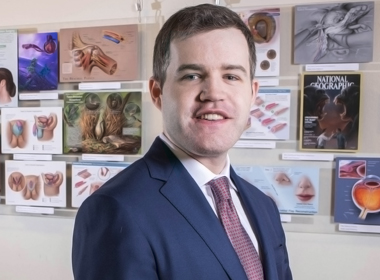Devin O’Brien Coon describes the life-changing surgeries that are part of his daily routine and that signal a new era at Johns Hopkins Medicine.
The day before, the plastic surgeon spent 10 hours reconstructing the bones of a face to make it appear more feminine.
The next day he will perform the first stage of a phalloplasty for a patient who is transitioning from female to male. This multistage operation will make a functional penis using tissue from the patient’s own forearm, and it will require complex microvascular and nerve surgery. The physician considers the 14-hour procedure to be the most challenging of the gender affirming surgeries he performs.
“It’s very ambitious in terms of the magnitude of what you’re trying to do,” he says. “Sewing 1-millimeter blood vessels together under the microscope is a very high stakes operation.”
Since the center opened in 2017, O’Brien Coon has performed roughly 150 gender affirming surgeries — at least a dozen of them phalloplasties; more surgeries are scheduled into August 2019. So far, nearly 900 people have requested transgender health related services that include primary care and hormone therapy.
“When we opened the Center for Transgender Health, we knew we were filling a largely unmet need for our patients. But the center’s reach and impact has exceeded all of our expectations,” says Redonda G. Miller, president of The Johns Hopkins Hospital.
The transgender health service involves 25 to 30 professionals across many departments, including plastic surgery, urology, gynecology, endocrinology, dermatology, mental health, nursing and social work.
Patients can receive hormone therapy, hair removal and voice therapy, along with gender affirming surgeries that include facial feminization, “top surgery” — chest masculinization mastectomy and breast augmentation, and “bottom surgery” — such as phalloplasty, metoidioplasty (which makes a penis from a clitoris that has been hormonally enlarged), hysterectomy and vaginoplasty, which creates a vagina.
In addition to his medical degree from the University of Pittsburgh, O’Brien Coon has a master’s degree in biomedical engineering from the Johns Hopkins University Whiting School of Engineering. He uses computer models that help him analyze what will work best for each patient. Every procedure he completes maps new territory in a surgical realm for which there are no best practices.
“There’s no good educational resource to tell you how to do a phalloplasty that is fully functional and has sensation. Everybody who wants to learn how to do it typically has to travel to watch it being done,” O’Brien Coon says. “In surgery, rare, highly specialized techniques are sometimes learned that way. In those situations, however, you can supplement that with textbooks and references. We don’t even have that.”
O’Brien Coon first performed genital affirming surgeries as part of his fellowship in the joint Johns Hopkins/University of Maryland plastic surgery program. He continued his training by observing internationally recognized plastic surgeons in Europe and the United States.
He wants to make it easier for those who follow. Since the center opened, he has worked closely with artist Hillary Wilson, a graduate of the Art as Applied to Medicine program, to create explanatory medical illustrations of bottom surgeries and facial feminization that serve as resources for patients, other surgeons and medical students. In conjunction with a team at the Johns Hopkins University School of Medicine, they are developing a self-paced online module to educate health care providers about a range of transgender health topics — the first module addresses gender affirming surgery.



